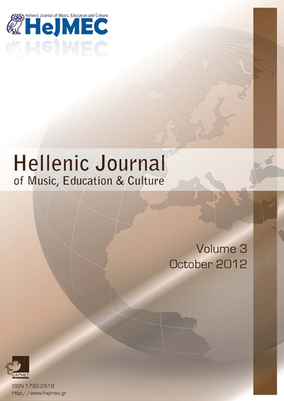Assessment of Musical Knowledge from a Life-World-Phenomenological Perspective. : The Challenge of Conceptualising and Communication.
Part of : Hellenic journal of music, education and culture ; Vol.2, No.1, 2011, pages 37-45
Issue:
Pages:
37-45
Author:
Abstract:
The article functions as a contribution to the current discussion about assessment thattakes place in several educational settings, at several levels. In those contexts the idea of howdifferent qualities of musical knowledge are expressed, is constituted and re-created through thesharing of experience. Still concepts and descriptions of the qualities, which should be possible touse as a base for discussion and reflection upon musical knowledge, are most often missing. Thecontribution in the discussion is based on a view of knowledge and learning takes a life-worldphenomenologicalway of thinking as a point of departure, based on Merleau-Ponty, Heidegger andDufrenne. The philosophy offers a base for a further discussion of the possibilities of, and challengesto how musical knowledge can be assessed, and how assessment can become a part of musicallearning. This article will take into account the multi-dimensional phenomenon of music, and how itinfluences the concepts of musical knowledge and learning. It will address the conceptualisation ofsuch knowledge, the weight of style and earlier experiences, the aspect of response in connection tolanguage, and how musical knowledge can be expressed and assessed in the spirit of intersubjectivity.
Subject:
Subject (LC):
Keywords:
Assessment, conceptualization, musical knowledge, life-worldphenomenology
References (1):
- Benson, B. E. (2003). The Improvisation of Musical Dialologue. Cambridge: Cambridge.Bloom, B. (ed.) (1956). Taxonomy of Educational Objectives. Handbook 1: CognitiveDomain. New York: David McKay.Burnard, P. & Lavicza, Z. (2010). Primary and secondary music and visual arts teachers‟conceptions and practices of Assesing Creativity in the Arts: Developing the ACA questionnaire. Proceedingsfor the 23rd International Seminar of Research in Music Educationa. In Changchun, China. 25th-30th ofJuly, 2010. 107-111.Dufrenne, M. (1953/1973). Phenomenology of Aesthetics. Evanston: Northwestern UniversityPress.Eisner, E. (2007). Assessment and evaluation in education and the arts. In Bresler, L. (eds. ).(2007). International Handbook of Research in Arts Education. Amsterdam: Springer Netherlands.Ford, C. (2010). Musical Presence: Towards a New Philosophy of Music. Contemporary Aesthetics. Vol. 8, 2010,26p. http://www.contempaesthetics.org/newvolume/pages/journal.phpHanna, W. (2007): The new Bloom‟s Taxonomy – Implications for music education. Arts Education PolicyReview. Vol. 108. No 4. March/April 2007. 7‐16.Heidegger, M. (1987). Konstverkets urprung. {The origin of the work of art}. Göteborg: Daidalos.Korp, H. (2006). Lika chanser på gymnasiet. En studie om betyg, nationella prov och social reproduktion.Malmö: Lärarutbildingen: Malmö Högskola.Kvernbekk, T. (2005). Pedagogisk teoridannelse. Insidere, teoriformer og praksis. Bergen: Fagbokforlaget.Langeveld, M. J. (1984). How does the child experience the world of things? Phenomenology and Pedagogy,2(3), 215-223.Merleau-Ponty, M. (1962). Phenomenology of Perception. New York: Routledge & Kegan Ltd.Merleau-Ponty, M. (1960/2000). Artes. Øyet og ånden. Oslo: Pax forlag.Merleau-Ponty, M. (2004). Lovtal till filosofin. Essäer i urval. Stockholm: Brutus Östlings förlag.Meyer-Drawe, K. (1986). Kaleidoscope of Experiences: Tha Capabiity to be Surpriced by Children. InPhenomenology and Pedagogy. Vol. 4, No. 3, pp. 48-55.Nielsen, F. V. (1997). Almen Musikdidaktik. Köpenhamn: Akademisk forlag.Pio, F. (2009). Pedagogy of sensuality and capability of life (livsdueglighed). The schools‟ path towardsreasessment of music as sensual-aesthetic subject. In: Nielsen, F. V., Holgersen, S-E., & S. GraabrækNielsen (eds.) Nordic Research in music education. Yearbook Vol. 11 (pp. 139-166). Oslo: NorgesMusikkhøgskole NNMH-publikasjoner 2009:8.Rui, E. (2010). Hvordan begrunner lærere karakterer de setter for hovedinstrumentfremføringertil. Vg2-elever iprogramområdet musikk? Presentation av masterarbete in press. NMH mars 2010.Sandberg, R. (2005). Curriculum Studies and Research in Music Education. Paper at the Nordic Network ofResearch on Music Education 10th Conference 13–15 January 2005 Stockholm.Schutz, A. (1964/1999). Den sociala världens fenomenologi. Göteborg: Daidalos.Varkøy, Ø. (2009). The role of music in music education research. In Nielsen, F. V., Holgersen, S-E., & S.Graabræk Nielsen (eds.) Nordic Research in music education. Yearbook Vol. 11 (pp. 33-48). Oslo:Norges Musikkhøgskole NNMH-publikasjoner 2009:8.Zandén, O. (2010). Samtal om samspel. Kvalitetsuppfattningar i musiklärares dialoger om ensemblespel pågymnasiet. [Discources on music-making. Conceptions of quality in music teacher‟s dialogues on uppersecondary school ensemble playing]. Diss. Gothenburg: Art Monitor.




